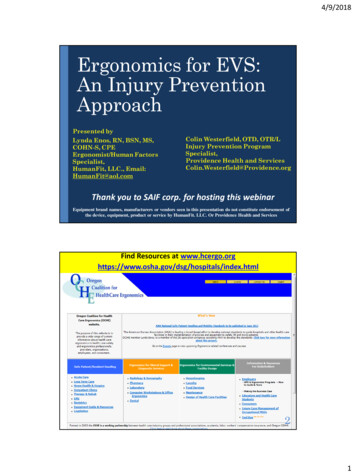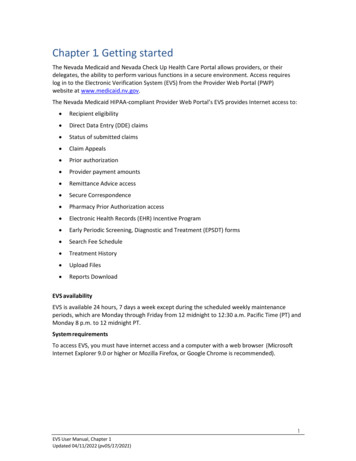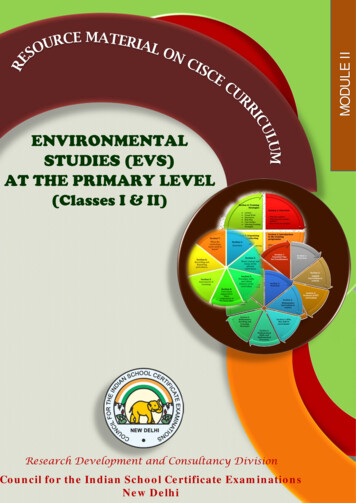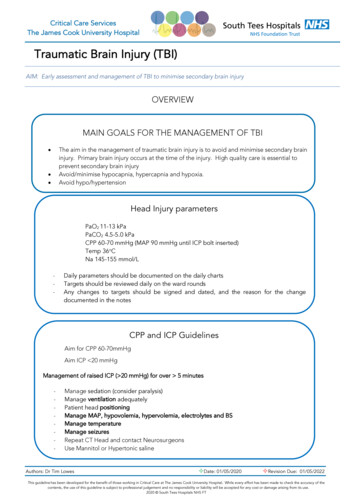
Transcription
4/9/2018Ergonomics for EVS:An Injury PreventionApproachPresented byLynda Enos, RN, BSN, MS,COHN-S, CPEErgonomist/Human FactorsSpecialist,HumanFit, LLC., Email:HumanFit@aol.comColin Westerfield, OTD, OTR/LInjury Prevention ProgramSpecialist,Providence Health and ServicesColin.Westerfield@Providence.orgThank you to SAIF corp. for hosting this webinarEquipment brand names, manufacturers or vendors seen in this presentation do not constitute endorsement ofthe device, equipment, product or service by HumanFit. LLC. Or Providence Health and ServicesFind Resources at ndex.html221
4/9/2018What are Musculoskeletal Disorders (MSDs)?(Cumulative Trauma Disorder, Repetitive Strain Injury, Overexertion or Overuse Injury)Acute:A sudden or one-time traumatic event or incident,e.g., slip, trip, fall or car wreckChronic or Cumulative:Injuries that occur over a period of timemonths/years) & are caused by a combination of riskfactorsMSDs affect ligaments, muscles, tendons,cartilage, blood vessels & nerves & spinal discs 3Reproduced with permission from HumanFit, LLC 2010-2017.4 Sprains & Strains Rotator Cuff Tear (shoulder) Lateral (or Medial)Epicondylitis (TennisElbow/Golfer’s elbow) Bursitis (shoulder or knees)Bricklayer's/Pitcher’sShoulder; Housemaid’s knee) Trapezius Myalgia (tensionneck syndrome) Low Back Pain/Bulging orHerniated Spinal Discs Tendonitis &Tenosynovitis Dequervain’s disease(Tendonitis of the thumb) Carpal Tunnel Syndrome (not associated withkeyboard use)Plantar Fasciitis (Foot)Trigger fingerReproduced with permission from HumanFit, LLC 2010-2017.2
4/9/20185Primary Risk Factors that can contribute to work related MSDs /Awkward, Static& Poor Postures /Force(Lift, Push, Pull,Carry, Grip Repetition al Factors: Contact Stress Vibration Environmental e.g., Cold/Heat/Noise/Light Psychosocial Factors e.g., perceived stress & low control of work environmentHumanFit, LLC 2011-2017.6The Cumulative EffectDuration – the length of exposure to a risk factorCan be all at one time or cumulative over the day, monthsor even years of exposure to ergonomic risk factors beforeit becomes a concern.Affected by: Working through breaksOvertimeTask variabilityWhen the musculoskeletal system is exposed to acombination of these risk factors (too quickly, toooften and for too long) without sufficient recoveryor rest time, damage occursHumanFit, LLC 2011-2017.3
4/9/20187Using Ergonomics to Prevent MSDsDesigning Tasks,Equipment, WorkEnvironments & Systems tobe compatible with theUsers’Physical & CognitiveCapabilities andPsychosocialCharacteristicsFittingtheTaskto theUserPreventing UserInjury & Error; Improving Comfort &Efficiency/Quality7HumanFit, LLC 2011-2017.Most EffectiveErgonomics Programs -Preventing MSDSHierarchy of ControlsPrimary Controls:Secondary Controls:1. Eliminate the riskfactor (s) throughdesign2. Work Practice changesEngineering of the: Task Tools Equipment Facilities83. Administrative - Reduceexposure of person to the job4. Warnings5. Training6. Personal Protective equipment7. Wellness & FitnessLeastEffective8Reproduced with permission from HumanFit, LLC 2010-2017.4
4/9/20189Culture (Behavior) Change & Program Sustainability Management Commitment (visible program champion) (equipment, safe work practices,proactive design)Employee Involvement (inc. labor)A Business Plan(strategic & tactical)Program Management(program facilitator)Worksite AnalysisHazard Prevention & Control Education & Training Disability Management(inc. ongoing coaching)(‘after action’ review)Multifaceted programs are more effective than any single interventionReproduced with permission from HumanFit, LLC 2010-2017.(NIOSH, 1997; OSHA 1991 & 2003; VAH 2014)Environmental Services (EVS) “Perform a variety of generalcleaning tasks to maintainpatient rooms, offices,hallways, and other assignedareas of the hospital.” “Move, remove, and relocatefurniture, furnishings,equipment, etc.” “Considerable reaching,stooping, bending, kneeling,crouching, moderate to heavyphysical effort (lift/carry/pushup to 50 lbs.).” “Prolonged, extensive, orconsiderablestanding/walking.”(Providence Health and Services, 2018)(CalOSHA, 2005)5
4/9/2018Injury rates for Janitors and Cleaners Incidence rates per 10,000 FTE Nonfatal occupational injuries and illnesses Days away from workAllJanitors and Cleaners, exceptoccupations Maids and HousekeepingCleaners (code 372011)2016201691.7178.6All Injuries & IllnessesMusculoskeletal disorders29.458.8Overexertion and bodilyreaction30.961.2Injuries, illnesses, and days awayccu a on0,000Overexertion leadingcause of injury0,0000,0000,0000aborers frei htstock and materialmoversHeavy and tractortrailer truck driversanitors and cleanersursin assistantsaintenance andre air workerseneral6
4/9/201813Direct Costs (Largely Workers Comp)Indirect Costs (e.g. temp and permanent staffreplacement costs) Operational Losses- Staff Turnover- Quality of Care/Service- Decreased Efficiency (Impact of Fatigue, Presenteeism, etc.)Cost of Compensating Actions (e.g. Training) “Human” Error & Accidents13Typical EVS Injuries Moving beds – “Moving bed and felt lower back pain” Lifting linen – “Lifted linen bag to drop in chute andinjured wrists” Pushing carts – “Pushing and pulling housekeeping cart” Mopping – “Mopping a room and heard arm pop” Cleaning – “Cleaning patient room and felt neck andshoulder pain” Cumulative Trauma – “My back is really sore”, “Numbnessand tingling in both hands”(Providence Health and Services,2018)7
181614121086420(blank)Exposure-Patient Repositioning-PHBBFEpush/pull-phStressPush/Pull General- Push/Pull-GeneralPush/Pull General- Needle/punctureMANUAL Cut/lacerationcumulative traumaExposure-Non- Struck by/AgainststfSlips, Trips, Falls4/9/20182017 EVS injuries by category84400 - ENVIRONMENTAL SERVICES(Providence Health and Services, 2018)Solutions8
4/9/2018Scrubbing and dustingChallengesSolutions Extreme reach (overhead) Long-handled tools Awkward posture(bending, kneeling,squatting) Angled or pivoting heads Adjustable handle lengths,cleaning heads as light aspossible (e.g. microfiber),battery-poweredscrubbers (EU-OSHA, 2009) Bent wrists, repetitivemotions and high gripforcesVacuumingChallenges Repetitive motions (hand,arm) Grip force Solutions Lighter weight canister Adjustable “Ergonomic”handlesPushing and pulling, liftingand lowering Self-propelled uprightvacuums Bending wrist and back Long hoses Noise (increasing stress andmuscle tension) Lower noise levels (EU-OSHA, 2009)9
4/9/2018Vacuum technology(Janitorialstore.com, 2018)BuffingChallenges Awkward position Torque when starting transfersvibration to upper extremity Heavy lifting Slip/trip/fall riskSolutions Self-propelled machine withwalk-behind or ride-on option Reduced vibration via productdesign, consistent maintenanceand servicing (EU-OSHA, 2009)Source: www.unoclean.com/10
4/9/2018MoppingSolutionsChallenges Heavy, awkward lifting Bending Squatting to lift bucket fromfloor Wringing Lifting and carrying wet mop Adjustable, light-weightequipment More ergonomic location ofsinks/taps Improved work practices andwork organization(EU-OSHA, 2009)(CalOSHA, 2005)Handling trash and linenChallenges Lifting heavy trash and linenbags from bins Creating vacuum in cans,which increases force toremove (trash) Significant push-pull forcesSolutions Replace large trash bins withsmaller, lighter bins Vent sides of trash cans Relocate dumpsters,compactors, and bins to beaccessed from above or tosafe operating height (EU-OSHA, 2009)11
4/9/2018Trash and linen risksMoving furnitureChallenges Lifting, carrying, pushing,and pulling furniture Operating furniture (e.g.patient recliners)Solutions Lighter furniture Wheeled furniture User-friendly furniturecontrols (EU-OSHA, 2009)(Aethon, 2018)12
4/9/2018Vancouver Island case study Partnership between 471-bed regional hospital andProvincial Workers’ Comp Board Aimed to eliminate linen lifting injuries, reduceMSDs, injury costs, and BBFEs Reduced 4 time-loss claims/year to Zero 9 % “good” or “excellent” on staff satisfactionsurvey 48,508 annual savings and initial 147,000investment recouped in 4 years (Newlands et al,2002)Mop and bucket study Mop/bucket risks andchallenges Flat-mop and backpackbenefits Newer, lightweightapplication(Brown, L., 2009)(CalOSHA, 2005)13
4/9/2018Mop study findings Muscle contraction and heartrate monitoring 36% less forearm flexor effort36% less erector spinae effort35% less deltoid effort 23%less trapezius effort Overall heart output was 50%less with new system(Brown, L., 2009)(CalOSHA, 2005)Vacuum backpack study Challenges of uprightvacuums Only forward-backmotion Pushing weight ofentire machine eachstroke Upright vacuumhandles positioncaregiver closer tofloor (Standley, S., Murray,C.,& Woellner, R., 2004)(CalOSHA, 2005)14
4/9/2018Vacuum pack benefits Upright body position Greater range of vacuummovement/coverage Decreased energy output andtwice the cleaning rate Reduced weight Traditional uprights 20-30lbs. New backpack technology 10lbs. Neutral position – Two-handedoperation, elbows locked at sides,which limits extreme reach Custom fit(Standley, S., Murray,C., & Woellner, R., 2004)(Webstaurantstore.com, 2018)Providence processes Collaboration among Workers’ Compensation, InjuryPrevention & Ergonomics, Safety, Caregiver Health,Executive Leadership, and Unit/Department Leadership Return-to-work/Transitional duty Employer-at-Injury Program (EAIP)15
4/9/2018Worksite and risk assessments Individualcaregivers Departmental riskassessments Training, inservicing(CalOSHA, 2005)Potential Program Funding Sources Employee at Injury Fund (EAIP) ( 5000 per injuredworker while on transitional duty- in Oregon Preferred Worker Program – to 50,000 (CalOSHA, 2005)16
4/9/2018Resources Brown, L. (February, 2009). Back benefits. Health Facilities Management. 35-39 CalOSHA. (2005). Working Safer and Easier for Janitors, Custodians, andHousekeepers. Retrieved fromhttps://www.dir.ca.gov/dosh/dosh publications/janitors.pdfErgonomics: Cleaning Rooms in Nursing mics/ergonomics-cleaningrooms-nursing-homes European Agency for Safety and Health at Work (EU-OSHA). (2009). Theoccupational safety and health of cleaning workers. Luxembourg: Office for theOfficial Publications of the European Communities. blications/literature reviews/cleaning workers and OSH Institute for Ergonomics – The Ohio State University. (2018). Ergonomics forHousekeepers – The basics. OSHA. Retrieved fromhttps://www.osha.gov/dte/grant materials/fy10/sh-2099810/Housekeeper Manager Ergo Handout.pdf Institute for Ergonomics – The Ohio State University. (2018) Ergonomics Resourcesfor Housekeeping. Retrieved from sekeeping Iowa State University. (2018). Environmental health and safety – Ergonomics.Retrieved from s/Resources ewlands et al (2002). “A world without linen ba s.” Retrieved ld-without-linen-bags?lang en Oregon Coalition for Healthcare Ergonomics (OCHE). (2018). Ergonomics forEnvironmental Services. Retrieved from http://www.hcergo.org/housekeeping/ Providence Health and Services. (2018). Environmental services technician.Retrieved from FD3C3FE466A05/job/ Standley, S., Murray,C., & Woellner, R. (December, 2004). Back talk. Health FacilitiesManagement. 33-36. The Duop SystemTM: An ergonomic solution for hotel housekeeping staff. A WhitePaper. Jack T. Dennerlein, Ph.D. and Dan Koval. 6 February les/duop white paper 2016.pdf Worksafe BC. (2016). What's Wrong with This Photo? (Janitorial photo-jan-feb-2016-janitorialsafety?lang en&origin s&returnurl et%3D%5BEnglish%5D17
4/9/201835Questions & Discussion3518
Lynda Enos, RN, BSN, MS, COHN-S, CPE Ergonomist/Human Factors Specialist, HumanFit, LLC., Email: HumanFit@aol.com Colin Westerfield, OTD, OTR/L Injury Prevention Program Specialist, Providence Health and Services Colin.Westerfield@Providence.org Equipment brand names, manufacturers or vendors seen in this presentation do not constitute .











